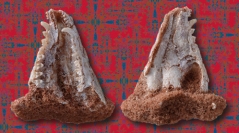

 Geodiversitas
44 (22) - Pages 609-643
Geodiversitas
44 (22) - Pages 609-643The present paper describes a partial skull referred to Incadelphys antiquus, from the early Palaeocene of Tiupampa (Bolivia). The specimen includes the anterior part of the skull with maxillae, premaxillae, nasals, lacrimals, anterior part of frontals and jugal, and both dentaries. Most of the teeth are preserved except some incisors. Some of the major characteristics of Incadelphys are the elongation and slenderness of the rostrum as compared to other Tiupampa taxa and the narrowness and blade-like morphology of the premolars. The new specimen is compared to the other Tiupampan pucadelphydans, especially, pucadelphyids, but also sparassodonts. Comparisons with Marmosopsis juradoi, from the early Eocene of Itaboraí and with Aenigmadelphys archeri from the latest Campanian of North America is also meaningful. Among others, the three genera share a strong distolabial extension of their metastylar area of the M1, which has not been observed, to a such extant, in other American metatherians. A phylogenetic parsimony analysis has been performed with exclusion some poorly known taxa, such as Jaskhadelphys minutus (two upper molars only), from Tiupampa or Kiruwamaq chisu (one M?3 only) from the late Eocene of Peru. The taxa included in our analysis are at least known from all upper and lower molars. The result of our analysis with unweighted characters retrieved the inclusion of Incadelphys, Marmosopsis, Szalinia and Aenigmadelphys in the clade Pucadelphyda, which also includes the Pucadelphyidae and the Sparassodonta. An analysis with downweighted homoplastic characters (with Goloboff K=3) resulted in a monophyletic grouping of Szalinia, Aenigmadelphys, Marmosopsis, and Incadelphys in an unnamed clade designated with the working term SAMI (after the initial of these four genera). This result, which we favor, is the first hypothesis which suggests a close relationship between the early Palaeocene - early Eocene, Tiupampa -Itaboraí pucadelphydans and a Late Cretaceous North American taxon, Aenigmadelphys, which is included within the Pucadelphyda.
Metatheria, Pucadelphyda, Marsupialia, early Palaeocene, Palaeogene, Tiupampa, Bolivia, cranial anatomy, phylogeny, new superfamily